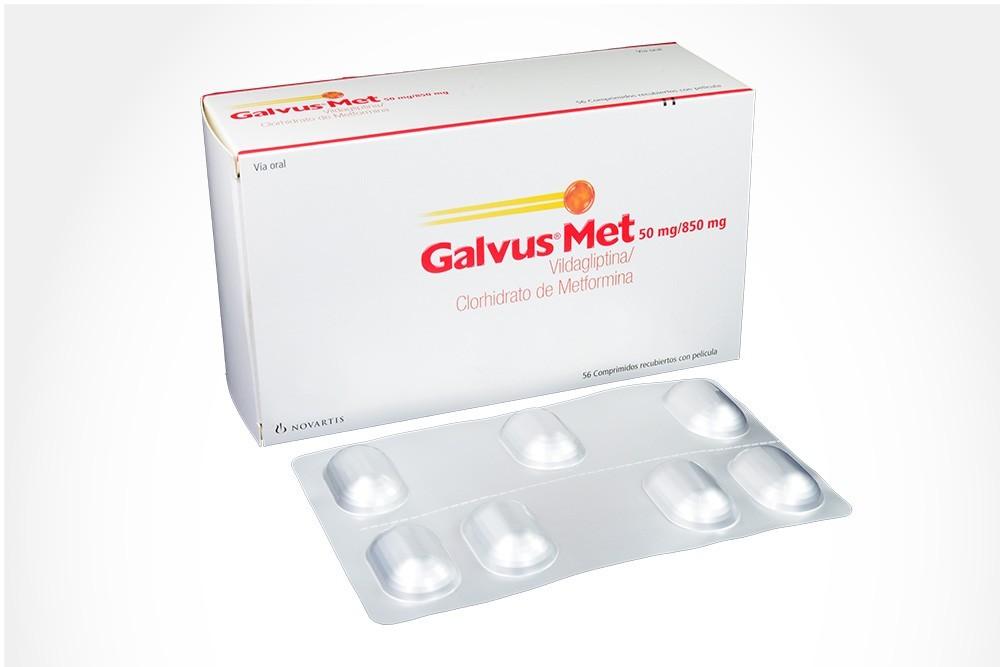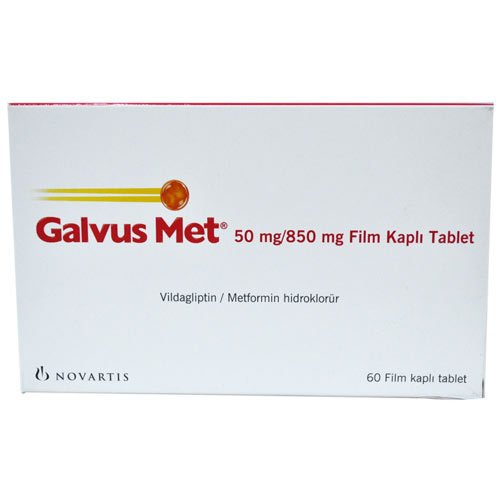Galvus Met 50mg/1000mg Tablet : Uses, Price, Side Effect
Name of the medicinal product
Galvus® 50 mg tabletsQualitative and quantitative composition
Each tablet contains 50 mg of vildagliptin.
Excipient with known effect: Each tablet contains 47.82 mg lactose (anhydrous).
For the full list of excipients, see section 6.1.
- Pharmaceutical form
Tablet.
White to light yellowish, round (8 mm diameter), flat-faced, bevelled-edge tablet. One side is debossed with “NVR”, and the other side with “FB”.
- Clinical particulars
4.1 Therapeutic indications
Vildagliptin is indicated in the treatment of type 2 diabetes mellitus in adults:
As monotherapy
- in patients inadequately controlled by diet and exercise alone and for whom metformin is inappropriate due to contraindications or intolerance.
As dual oral therapy in combination with
metformin, in patients with insufficient glycaemic control despite maximal tolerated dose of monotherapy with metformin,
a sulphonylurea, in patients with insufficient glycaemic control despite maximal tolerated dose of a sulphonylurea and for whom metformin is inappropriate due to contraindications or intolerance,
a thiazolidinedione, in patients with insufficient glycaemic control and for whom the use of a thiazolidinedione is appropriate.
As triple oral therapy in combination with
- a sulphonylurea and metformin when diet and exercise plus dual therapy with these medicinal products do not provide adequate glycaemic control.
Vildagliptin is also indicated for use in combination with insulin (with or without metformin) when diet and exercise plus a stable dose of insulin do not provide adequate glycaemic control.
4.2 Posology and method of administration
Posology
Adults
When used as monotherapy, in combination with metformin, in combination with thiazolidinedione, in combination with metformin and a sulphonylurea, or in combination with insulin (with or without metformin), the recommended daily dose of vildagliptin is 100 mg, administered as one dose of 50 mg in the morning and one dose of 50 mg in the evening.

When used in dual combination with a sulphonylurea, the recommended dose of vildagliptin is 50 mg once daily administered in the morning. In this patient population, vildagliptin 100 mg daily was no more effective than vildagliptin 50 mg once daily.
When used in combination with a sulphonylurea, a lower dose of the sulphonylurea may be considered to reduce the risk of hypoglycaemia.
Doses higher than 100 mg are not recommended.
If a dose of Galvus is missed, it should be taken as soon as the patient remembers. A double dose should not be taken on the same day.
The safety and efficacy of vildagliptin as triple oral therapy in combination with metformin and a thiazolidinedione have not been established.
Additional information on special populations
Elderly (≥ 65 years)
No dose adjustments are necessary in elderly patients (see also sections 5.1 and 5.2).
Renal impairment
No dose adjustment is required in patients with mild renal impairment (creatinine clearance ≥ 50 ml/min). In patients with moderate or severe renal impairment or with end-stage renal disease (ESRD), the recommended dose of Galvus is 50 mg once daily (see also sections 4.4, 5.1 and 5.2).

Hepatic impairment
Galvus should not be used in patients with hepatic impairment, including patients with pre-treatment alanine aminotransferase (ALT) or aspartate aminotransferase (AST) > 3x the upper limit of normal (ULN) (see also sections 4.4 and 5.2).
Paediatric population
Galvus is not recommended for use in children and adolescents (< 18 years). The safety and efficacy of Galvus in children and adolescents (< 18 years) have not been established. No data are available (see also section 5.1).
Method of administration
Oral use
Galvus can be administered with or without a meal (see also section 5.2).
4.3 Contraindications
Hypersensitivity to the active substance or to any of the excipients listed in section 6.1.
4.4 Special warnings and precautions for use
General
Galvus is not a substitute for insulin in insulin-requiring patients. Galvus should not be used in patients with type 1 diabetes or for the treatment of diabetic ketoacidosis.
Renal impairment
There is limited experience in patients with ESRD on haemodialysis. Therefore Galvus should be used with caution in these patients (see also sections 4.2, 5.1 and 5.2).
Hepatic impairment
Galvus should not be used in patients with hepatic impairment, including patients with pre-treatment ALT or AST > 3x ULN (see also sections 4.2 and 5.2).
Liver enzyme monitoring
Rare cases of hepatic dysfunction (including hepatitis) have been reported. In these cases, the patients were generally asymptomatic without clinical sequelae and liver function test results returned to normal after discontinuation of treatment. Liver function tests should be performed prior to the initiation of treatment with Galvus in order to know the patient's baseline value. Liver function should be monitored during treatment with Galvus at three-month intervals during the first year and periodically thereafter. Patients who develop increased transaminase levels should be monitored with a second liver function evaluation to confirm the finding and be followed thereafter with frequent liver function tests until the abnormality(ies) return(s) to normal. Should an increase in AST or ALT of 3x ULN or greater persist, withdrawal of Galvus therapy is recommended.
Patients who develop jaundice or other signs suggestive of liver dysfunction should discontinue Galvus.
Following withdrawal of treatment with Galvus and LFT normalisation, treatment with Galvus should not be reinitiated.
Cardiac failure
A clinical trial of vildagliptin in patients with New York Heart Association (NYHA) functional class I-III showed that treatment with vildagliptin was not associated with a change in left-ventricular function or worsening of pre-existing congestive heart failure (CHF) versus placebo. Clinical experience in patients with NYHA functional class III treated with vildagliptin is still limited and results are inconclusive (see section 5.1).
There is no experience of vildagliptin use in clinical trials in patients with NYHA functional class IV and therefore use is not recommended in these patients.
Skin disorders
Skin lesions, including blistering and ulceration have been reported in extremities of monkeys in non-clinical toxicology studies (see section 5.3). Although skin lesions were not observed at an increased incidence in clinical trials, there was limited experience in patients with diabetic skin complications. Furthermore, there have been post-marketing reports of bullous and exfoliative skin lesions. Therefore, in keeping with routine care of the diabetic patient, monitoring for skin disorders, such as blistering or ulceration, is recommended.
Acute pancreatitis
Use of vildagliptin has been associated with a risk of developing acute pancreatitis. Patients should be informed of the characteristic symptom of acute pancreatitis.
If pancreatitis is suspected, vildagliptin should be discontinued; if acute pancreatitis is confirmed, vildagliptin should not be restarted. Caution should be exercised in patients with a history of acute pancreatitis.
Hypoglycaemia
Sulphonylureas are known to cause hypoglycaemia. Patients receiving vildagliptin in combination with a sulphonylurea may be at risk for hypoglycaemia. Therefore, a lower dose of sulphonylurea may be considered to reduce the risk of hypoglycaemia.
Excipients
The tablets contain lactose. Patients with rare hereditary problems of galactose intolerance, the Lapp lactase deficiency or glucose-galactose malabsorption should not take this medicinal product.
#copied:https://www.1mg.com/drugs/galvus-met-50mg-1000mg-tablet-161866